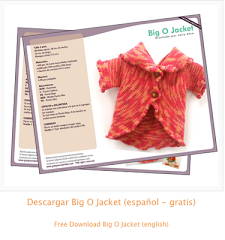Cast on is the starting point of the work. The cast on row never counts in calculations.
The methods described below are only diferent ways of holding the needles and yarn when casting on, find the method easier for you.
Double Cast-on:
There are many ways of casting on and here I describe a one needle method. You can use the index or thumb finger to cast on with one needle (Also known as The Thumb Method), this method is used whenever a less noticeable, very elastic edge is needed, or when the rows immediately after the cast on edge are worked in garter stitch or stocking stitch.
Recommend that left-handed knitters use the same technique as right-handed ones (unlike crochet).
 1. Wrap the tail end of the yarn around your right thumb and your index finger, front to back. Use your ring finger and little finger to help tension the yarn.
1. Wrap the tail end of the yarn around your right thumb and your index finger, front to back. Use your ring finger and little finger to help tension the yarn.
 2. Pull your right thumb down. Use your index finger to end up with a loop as seen below.
2. Pull your right thumb down. Use your index finger to end up with a loop as seen below.
 3. Insert the needle tip into the loop without removing your finger.
3. Insert the needle tip into the loop without removing your finger.
 4. Wrap the (yellow) yarn from the ball around the needle knitwise and knit one stitch and let the yarn (orange) drop off.
4. Wrap the (yellow) yarn from the ball around the needle knitwise and knit one stitch and let the yarn (orange) drop off.
 5. Adding 1 stitch.
5. Adding 1 stitch.
Repeat Steps 1–5 until you have the required number of stitches. Take care to pull the yarn evenly so that you cast-on edge has a even tension.
Single Cast On (Backward Loop Cast on):
This cast-on is probably the easiest to learn, but it doesn't have a neat edge like other cast-ons. This cast-on tends to grow longer and become less manageable as you work the first row of knitting, and the cast-on stitches tighten, making it difficult to insert the needle.
First stitch: Make a loop around your thumb and insert one needle in the loop, draw a loop through to make a stitch and close the stitch up to the needle. Or make a slip knot in the end of a ball of yarn and slide this loop onto one needle.
Continue as follows:
1. Holding the needle in your left hand and the yarn in your right hand, make a loop around your thumb.
2. Insert the loop in the needle, slip your thumb out, and gently pull the yarn to make a stitch on the needle.
Repeat Steps 1–2 until you have the required number of stitches
Cable Cast On:
(See also Knitting-On, which can be substituted)
A Cable Cast On is a good way to cast on stitches in the first or middle of your knitting. Often a pattern asks you to be knitting along and then says, cast on some number of stitches.
1. Start with a slip knot on the left hand needle.
2. Insert the right hand needle into the slip knot as if to knit. Wrap and pull through, just like a regular knit stitch but leaving the stitch on the left needle.
3. Place the new stitch back onto the left hand needle tansferring it with a twist. Two stitches now on the left hand needle.
4. Now insert the needle BETWEEN last two stitches on left needle. Wrap and bring through, transferring with a twist the newly created stitch onto the left hand needle.
Repeat step 4 for each stitch to be cast on.
You can also place the stitch on the needle purl-wise.
Long Tail Cast On:
(also known as Double Cast-On or Two-Strand Cast-On Method)
It's atractive and easy to knit from, easy to pick up stitches from. This cast on method creates an even, elastic edge that works well for stockinette stitch or for ribbing.
Only need one needle.
-Begin by pulling a long tail from the end of the working yarn, unravel a length that is approximately 3 times the required finished length of your knitting.
- Wind the yarn round your thumb and index finger from front to back (the tail of the yarn is on your index finger). Grasp both ends of yarn in the remaining three fingers to keep tension on the yarn. Or Make a slip knot on your right needle. This slip knot will count as your first stitch.
- Place the needle in the triangle of yarn that is formed.
- Bring the tip up through the loop on your thumb...
- Then down through the loop on your index finger, grabbing the yarn...
- And pulling it down through the loop on your thumb...
- ...let the loop of yarn on your thumb slip off.
- Bring your thumb back under the loose strand of yarn to tighten the stitch on the needle.
- Only first time the result is two cast on stitches.
- Repeat until you have the desired number of stitches on your needle.
A new stitch is formed each time.
Knitting On:
- Start with a slip knot on the left hand needle.
- You'll need 2 needles for this type of cast on.
- Insert the right hand needle into the slip knot as if to knit.
- Wap and pull through, just like a regular knit stitch.
- Place the newly created stitch back onto the left hand needle.
- Transferring it with a twist (or directly).
- Repeat for each stitch to be cast on.
Next article: Holding Needles and Yarn



0 comentarios:
Publicar un comentario en la entrada